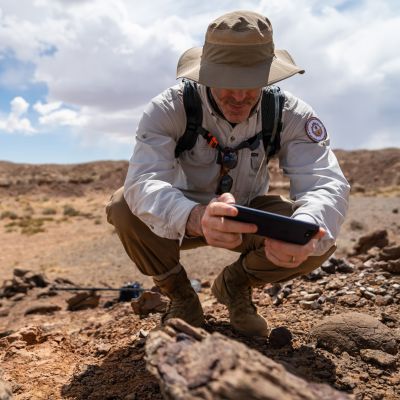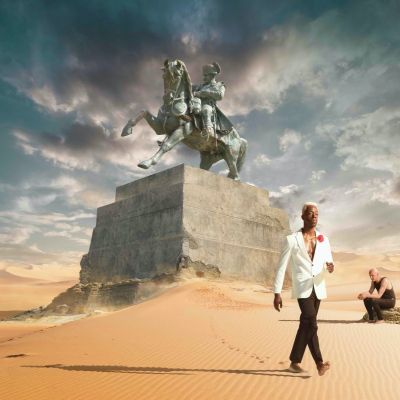Moving Mountains

A luxury lodge is assisting animals and humans alike towards a positive future in East Africa.

Rising dramatically from the East African landscape, the Virunga Mountains are a mighty chain of eight volcanoes, stretching across the borders of Uganda, Rwanda and the Democratic Republic of the Congo (DRC). They provide the setting for a complex story of conservation, displacement and rescue in one of the most beautiful parts of the world.
Praveen Moman is the founder and owner of luxury lodge company Volcanoes Safaris, and since 1997, Volcanoes Safaris has been at the forefront of gorilla and chimpanzee conservation and tourism in Uganda and Rwanda.
Volcanoes’ four lodges include Virunga, a luxury gorilla experience in Rwanda; Mount Gahinga in Uganda for gorilla tracking, Batwa culture and trekking; Bwindi Lodge in Uganda for gorilla tracking and trekking; and Kyambura Gorge, a contemporary chimpanzee and wildlife lodge in Uganda. I visited Mount Gahinga Lodge at the foot of the Mgahinga Mountains, which were declared a national park in 1991.
The land around the lodge was lush, with clear blue skies over landscapes of neatly farmed green fields strewn with large volcanic rocks deposited there by past eruptions from the surrounding mountains.

Getting to the lodge was an adventure of its own. After a one-hour flight from Entebbe to the nearest landing strip to the lodge, you bounce for an hour along bumpy, ungraded dirt roads with gigantic potholes, passing through dusty but vibrant towns, surrounded by beautiful green valleys.
It was at the lodge I met Dr Johannes Refisch of the UN’s Great Apes Survival Partnership (GRASP), a leading researcher on great apes. There are no mountain gorillas in captivity; they wouldn’t survive. The gorillas you see in zoos are not mountain gorillas, but the more populous lowland gorillas from the forests of Central Africa. With their precise habitat needs, mountain gorillas are found only on the Virungas, and in Uganda’s Bwindi Impenetrable Forest Park. It is a fragile population, and their continued protection is imperative. Today, if just one of them caught a life-threatening human disease such as Ebola, they could be wiped out in the blink of an eye.
In 1985 there were just 248 of these endangered mountain gorillas left in the world. Thanks to the work of conservationists such as Dr Johannes Refisch and Moman, the future looks positive.
“Today, there are 1,004, with 604 living in 41 social groups in Uganda, Rwanda and DRC, and another 400 in Bwindi. Despite the many challenges, including insecurity in DRC, the numbers have gone up. And this does not only benefit conservation, as it creates tangible economic benefits for local communities as well,” says Dr Refisch.
The three countries, Uganda, Rwanda and DRC, do not provide mountain gorilla population numbers per country, as this is a truly transboundary population and mountain gorilla groups or individuals cross the country borders regularly.

For centuries, the Gahinga Batwa people, a group of forest-dwelling hunter gatherers, and our oldest-surviving indigenous people and our own important ancestors (once referred to as pygmies) lived side by side with the gorillas. The Batwa were not a major threat to the gorillas, but 25 years ago they were evicted from their forest homes as part of gorilla conservation projects.
The Batwa became conservation refugees. With no support from the government or anyone else, displaced, unwanted and desperate, they lived an alien lifestyle on the forest edge. They worked on farms and took manual labouring jobs, but their future was bleak.
It was Moman, whose years of working in tourism and gorilla conservation had made him a close student of the Batwa and their culture, who finally came to the rescue.
Moman bought 10 acres of land close to Gahinga Lodge. He purchased building materials and asked architect Felix Holland of Studio FH Architects, who is the architectural consultant for Moman’s own lodges, to work alongside the Batwa and design a village using their ideas.
In 2017, I was in Uganda for the official opening of the Batwa village, a permanent settlement for the community of 100 adults and children, 25 years after they were forced out of the Mgahinga National Park. “I knew the Batwa existed since the first time I came here,” says Moman. “I thought: why shouldn’t we do something, because they are our neighbours, our people, they’ve been thrown out of the park, with no rights or land?”

At first the Batwa were reluctant; others had let them down so badly. Nevertheless, building started in 2017, Moman’s organisation providing the materials and land, and the Batwa building the houses. “Every time I came to the village, the Batwa seemed more alert and proactive, they had more hope.”
Moman collaborated at length with the Batwa, discussing what materials to use. The outcome is a timber sub-frame of eucalyptus poles, and a bamboo grid covered with earth plaster that holds everything together. These self-sustaining materials are free and can be maintained by the home occupiers. The soil used for the plaster was not local, it had to be fetched from miles away and for months they carried everything on their heads, always engaged and excited and appreciative. Their goal is now to be self-sufficient landowners.
At the nearby community centre, a large, thatched structure and the main focal point of the village, their skilled basketwork and carvings and other craftwork can be purchased; another opportunity for the Batwa to create income. There’s also a Batwa Heritage Trail close to Mount Gahinga Lodge, where Batwa children, and visitors, can connect to the Batwa’s ancestral past.
The community centre also acts as a performance space, and the plan is to start adult education, for which it will make a great classroom.
Visitors at Mount Gahinga Lodge can visit the village, which is a short walk through the surrounding farmland. It continues to be supported by Volcanoes Safaris, and Volcanoes Safaris Partnership Trust (VSPT), as well as donations from Volcanoes guests.
The Batwa are a people who had everything taken from them, yet Moman has offered them a chance to improve their lives, and through mutual trust and respect, they will continue to build a future. In the forests of the Virunga Mountains, and just below, the future looks positive for animals and humans alike.









